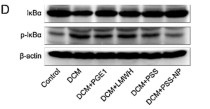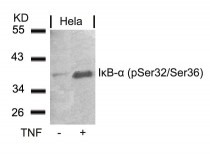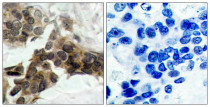ARG51651
anti-IKB alpha phospho (Ser32 / Ser36) antibody
anti-IKB alpha phospho (Ser32 / Ser36) antibody for ICC/IF,IHC-Formalin-fixed paraffin-embedded sections,Western blot and Human,Mouse,Rat
Cancer antibody; Gene Regulation antibody; Immune System antibody; Signaling Transduction antibody; IκB alpha degradation Study antibody; NF-kB Activation Study antibody
Overview
| Product Description | Rabbit Polyclonal antibody recognizes IKB alpha phospho (Ser32 / Ser36) |
|---|---|
| Tested Reactivity | Hu, Ms, Rat |
| Tested Application | ICC/IF, IHC-P, WB |
| Host | Rabbit |
| Clonality | Polyclonal |
| Isotype | IgG |
| Target Name | IKB alpha |
| Antigen Species | Human |
| Immunogen | Peptide sequence around phosphorylation site of serine 32/36 (H-D-S(p)-G-L-D-S(p)-M-K) derived from Human IκB-α. |
| Conjugation | Un-conjugated |
| Alternate Names | NFKBI; I-kappa-B-alpha; IkB-alpha; NF-kappa-B inhibitor alpha; Major histocompatibility complex enhancer-binding protein MAD3; IKBA; IkappaBalpha; MAD-3 |
Application Instructions
| Application Suggestion |
|
||||||||
|---|---|---|---|---|---|---|---|---|---|
| Application Note | * The dilutions indicate recommended starting dilutions and the optimal dilutions or concentrations should be determined by the scientist. |
Properties
| Form | Liquid |
|---|---|
| Purification | Antibodies were produced by immunizing rabbits with KLH-conjugated synthetic phosphopeptide. Antibodies were purified by affinity-chromatography using epitope-specific phosphopeptide. In addition, non-phospho specific antibodies were removed by chromatogramphy using non-phosphopeptide. |
| Buffer | PBS (without Mg2+ and Ca2+, pH 7.4), 150mM NaCl, 0.02% Sodium azide and 50% Glycerol. |
| Preservative | 0.02% Sodium azide |
| Stabilizer | 50% Glycerol |
| Concentration | 1 mg/ml |
| Storage Instruction | For continuous use, store undiluted antibody at 2-8°C for up to a week. For long-term storage, aliquot and store at -20°C. Storage in frost free freezers is not recommended. Avoid repeated freeze/thaw cycles. Suggest spin the vial prior to opening. The antibody solution should be gently mixed before use. |
| Note | For laboratory research only, not for drug, diagnostic or other use. |
Bioinformation
| Database Links | |
|---|---|
| Gene Symbol | NFKBIA |
| Gene Full Name | nuclear factor of kappa light polypeptide gene enhancer in B-cells inhibitor, alpha |
| Background | Inhibits the activity of dimeric NF-kappa-B/REL complexes by trapping REL dimers in the cytoplasm through masking of their nuclear localization signals. On cellular stimulation by immune and proinflammatory responses, becomes phosphorylated promoting ubiquitination and degradation, enabling the dimeric RELA to tranlocate to the nucleus and activate transcription. |
| Function | Inhibits the activity of dimeric NF-kappa-B/REL complexes by trapping REL dimers in the cytoplasm through masking of their nuclear localization signals. On cellular stimulation by immune and proinflammatory responses, becomes phosphorylated promoting ubiquitination and degradation, enabling the dimeric RELA to translocate to the nucleus and activate transcription. [UniProt] |
| Highlight | Related Antibody Duos and Panels: ARG30037 Phospho IKB alpha Antibody Duo (Total, pS32/36) ARG30205 NFkB Activation Antibody Panel Related products: IKB alpha antibodies; IKB alpha Duos / Panels; Anti-Rabbit IgG secondary antibodies; Related news: Treatment of Obesity with Celastrol Tumor microenvironments are shown to affect progression of several cancer subtypes Immune signaling protein TLR4 has opposing roles in breast cancer development |
| Research Area | Cancer antibody; Gene Regulation antibody; Immune System antibody; Signaling Transduction antibody; IκB alpha degradation Study antibody; NF-kB Activation Study antibody |
| Calculated MW | 36 kDa |
| PTM | Phosphorylated; disables inhibition of NF-kappa-B DNA-binding activity. Phosphorylation at positions 32 and 36 is prerequisite to recognition by UBE2D3 leading to polyubiquitination and subsequent degradation. Sumoylated; sumoylation requires the presence of the nuclear import signal. Sumoylation blocks ubiquitination and proteasome-mediated degradation of the protein thereby increasing the protein stability. Monoubiquitinated at Lys-21 and/or Lys-22 by UBE2D3. Ubiquitin chain elongation is then performed by CDC34 in cooperation with the SCF(FBXW11) E3 ligase complex, building ubiquitin chains from the UBE2D3-primed NFKBIA-linked ubiquitin. The resulting polyubiquitination leads to protein degradation. Also ubiquitinated by SCF(BTRC) following stimulus-dependent phosphorylation at Ser-32 and Ser-36. Deubiquitinated by porcine reproductive and respiratory syndrome virus Nsp2 protein, which thereby interferes with NFKBIA degradation and impairs subsequent NF-kappa-B activation. |
Images (4) Click the Picture to Zoom In
-
ARG51651 anti-IKB alpha phospho (Ser32 / Ser36) antibody WB image
Western blot: Rat cardiac stained with ARG51651 anti-IKB alpha phospho (Ser32 / Ser36) antibody at dilution.
From Yongjun Mao et al. Biomed Pharmacother. (2020), doi: 10.1016/j.biopha.2019.109280, Fig. 6D.
-
ARG51651 anti-IKB alpha phospho (Ser32 / Ser36) antibody WB image
Western blot: Extracts from HeLa cells untreated or treated with TNF stained with ARG51651 anti-IKB alpha phospho (Ser32 / Ser36) antibody.
-
ARG51651 anti-IKB alpha phospho (Ser32 / Ser36) antibody IHC-P image
Immunohistochemistry: Paraffin-embedded Human breast carcinoma tissue stained with ARG51651 anti-IKB alpha phospho (Ser32 / Ser36) antibody (left) or the same antibody preincubated with blocking peptide (right).
-
ARG51651 anti-IKB alpha phospho (Ser32 / Ser36) antibody ICC/IF image
Immunofluorescence: methanol-fixed HeLa cells stained with ARG51651 anti-IKB alpha phospho (Ser32 / Ser36) antibody.
Specific References











